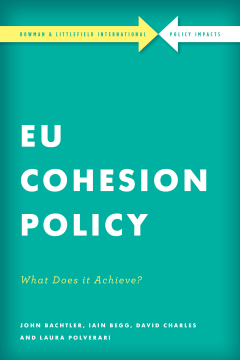
BOOK
EU Cohesion Policy in Practice
John Bachtler | Iain Begg | David Charles | Laura Polverari
(2016)
Additional Information
Book Details
Abstract
EU Cohesion policy, along with support for agriculture and rural development, is one of the main items of EU spending. As such, the performance of the policy has come under increasing scrutiny. Perhaps surprisingly, however, past attempts to assess the effectiveness of the EU’s have proved to be highly ambivalent.
This book examines the long-term achievements of Cohesion policy from 1989 to 2012 and draws out the main policy implications. Originally undertaken for the European Commission by the authors, this major longitudinal study adopts an innovative approach to assessing the effectiveness and achievements of this policy, building on case studies of 15 regions from different parts of Europe. The rationale for the book is to present the findings of the research in a concise and digestible manner that will be of value to policy-makers across the EU and to academics interested in the past effectiveness and future direction of the policy. The research brings out messages for the conduct of Cohesion policy in the current programme period, covering 2014-2020. It also has implications for the debates, already launched, on how Cohesion policy might evolve after 2020."
Lack of adequate evaluation has traditionally been the Achilles’ heel of European cohesion policy. 'EU Cohesion Policy in Practice' represents an important step to cover this gap by focusing on the capacity of the EU regional intervention to address the everyday needs of European citizens. The book makes extensive and insightful use of a large number of case studies and should be a must for all those interested in knowing the extent to which the EU cohesion policy delivers.
Andrés Rodríguez-Pose, London School of Economics
This is an excellent book by some of the best scholars in the field. It deals with both the big-picture challenges and opportunities faced by EU cohesion policy alongside the granular and specific issues faced daily. There are many lessons here not only for European scholars, but for scholars and policy makers worldwide working in regional and urban development policy.
Philip McCann, University of Groningen
It is the first theoretically sound, and at the same time empirically rich study examining performance of the Cohesion policy funds since 1988 across the regions from different EU countries. Written by outstanding, experienced British scholars. Objective, precise and informative. Of great usefulness for academics and practitioners. Nobody interested in Cohesion policy can miss this book.
Grzegorz Gorzelak, Professor, EUROREG, University of Warsaw
John Bachtler is Professor of European Policy Studies and Director of the European Policies Research Centre at the University of Strathclyde.
Iain Begg is a Professorial Research Fellow at the European Institute, London School of Economics and Political Science.
David Charles is Professor of Innovation and Strategic Management at the Lincoln Business School, University of Lincoln.
Laura Polverari is Senior Research Fellow in the European Policies Research Centre, University of Strathclyde
Examining the cohesion policies of the EU from 1989 to 2012, this study assesses the success and effectiveness of the policy, particularly in relation to its large budget. The authors endeavour to provide EU policy makers and academics with lessons drawn from 15 case studies around Europe.
Table of Contents
| Section Title | Page | Action | Price |
|---|---|---|---|
| Contents | v | ||
| List of Tables, Figures and Boxes | vii | ||
| Preface | ix | ||
| Ch01. Introduction | 1 | ||
| Ch02. The Evaluation of EU Cohesion Policy | 9 | ||
| Ch03. A Different Approach to Evaluating Cohesion Policy | 15 | ||
| Ch04. What Was the Problem? | 25 | ||
| Ch05. Regional Strategies and Their Relevance to Needs | 39 | ||
| Ch06. The Effectiveness of Programmes in Achieving Objectives | 55 | ||
| Ch07. The Relevance of Programmes to Regional Needs Utility | 79 | ||
| Ch08. Implications for the Design and Implementation of Policies and Programmes | 95 | ||
| Ch09. Conclusions | 109 | ||
| Bibliography | 125 | ||
| Index | 135 |
